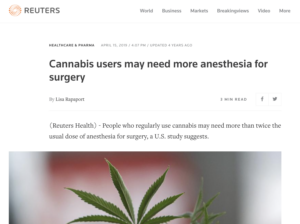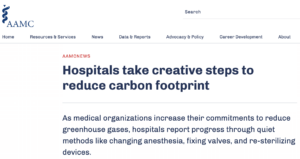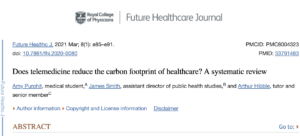https://nypost.com/2023/01/30/doctors-recommend-cutting-anesthesia-to-combat-climate-change/
Docs suggest reducing anesthesia: Would you suffer to combat climate change?
By Adriana Diaz
Experts are now recommending that doctors reduce their use of certain kinds of anesthesia in order to combat the effects of climate change.
Dr. Mohamed Fayed, a senior anesthetist at Detroit’s Henry Ford Health, made the suggestion during the American Society of Anesthesiologists’ annual conference last Friday in Orlando, Florida. (LINK)
“Global warming is affecting our daily life more and more, and the reduction of greenhouse gas emissions has become crucial,” he said.
Dr. Fayed added, “No matter how small each effect is, it will add up. As anesthesiologists, we can contribute significantly to this cause by making little changes in our daily practice — such as lowering the flow of anesthetic gas — without affecting patient care.”
Research notes that inhaled anesthesia accounts for up to 0.1% of the world’s carbon emissions, which are regarded as the primary driver of global climate change.
An hour of surgery using an inhaled anesthetic is equivalent to driving as many as 470 miles, according to a 2010 study.
Most general anesthesia procedures require a high fresh gas flow at the start and end of a procedure to quickly achieve the desired effect. But, according to Fayed, it is safe and effective to lower the flow at other times.
Anesthesia must be expertly administered: Too much of a drug can result in brain damage, coma or even death. But too little can mean a patient waking up during the procedure and experiencing intense pain, not to mention psychological trauma.
For their study, researchers from Henry Ford Health dialed down gas flow in an effort to reduce anesthesia use to under 3 liters every minute per surgery whenever possible.
This effort focused on the use of inhaled anesthetics only and produced a substantial decrease in use of the drugs, sometimes by as much as half.
Medical experts at Henry Ford Health also removed the drug desflurane from all operating rooms, noting that it produces the most significant carbon-dioxide emissions.
Data was gathered from 13,000 patients who underwent anesthesia from March 2021 to July 2021. Prior to the intervention, 65% of cases were limited to the 3 L/m threshold. By the end, 93% of cases achieved that.
“For a long time, there was a notion that the greenhouse effect caused in health care settings was an inevitable and unavoidable cost of providing patient care,” said Dr. Fayed.
“But we have learned that reducing anesthetic gas flow is one of the many ways health care can lessen its contribution to the global warming crisis, along with reducing waste, turning off lights and equipment when not in use and challenging practice habits, as long as they don’t compromise patient care.”
The researchers now are aiming to reduce the level of fresh gas flow to less than 2 L/m throughout the system.
#
Reuters: Cannabis users may need ‘more than TWICE usual dose’ of anesthesia for surgery – “People who regularly use cannabis may need more than twice the usual dose of anesthesia for surgery, a U.S. study suggests.”
Study in American Cancer Society Journal in 2020 Fretted over ‘carbon footprint of cancer care’ – From 2020: ACS Journal: “Climate change and cancer” – Excerpt: “To date, no studies have estimated the carbon footprint of cancer care…The energy expenditure associated with operating cancer treatment facilities and medical devices, as well as the manufacturing, packaging, and shipment of devices and pharmaceuticals, contributes significantly to greenhouse gas emissions in cancer care…Some cancer treatment facilities have begun to consider their own carbon footprint and started a process to achieve carbon neutrality. However, the proportion of health care institutions reporting environmental sustainability activities lags behind other economic sectors”
How many can they come up with? Surgery Causes Global Warming?! Study Shows ‘Anesthesia Agent Is Greatest Potential Contributor to Global Warming’ – Claim: ‘Anesthetics used by a busy hospital contribute as much to global warming as the emissions from hundreds of cars per year’-
Claim: Surgical General Anesthetic is Contributing to Climate Change – Switching from general to regional anaesthetics may help cut greenhouse emissions and ultimately help reduce global warming, a new study claims. While regional anaesthetics numb a certain part of the body, general anaesthetics make patients totally unconscious for what tend to be more serious procedures. But unlike regional anaesthetics, generals use volatile and environmentally-unfriendly halogenated agents, such as desflurane, or nitrous oxide. … ‘Green-gional’ anesthesia: the non-polluting benefits of regional anesthesia to decrease greenhouse gases and attenuate climate change
#How many can they come up with? Surgery Causes Global Warming?! Study Shows ‘Anesthesia Agent Is Greatest Potential Contributor to Global Warming’ – Claim: ‘Anesthetics used by a busy hospital contribute as much to global warming as the emissions from hundreds of cars per year’-
Claim: Surgical General Anesthetic is Contributing to Climate Change – Switching from general to regional anaesthetics may help cut greenhouse emissions and ultimately help reduce global warming, a new study claims. While regional anaesthetics numb a certain part of the body, general anaesthetics make patients totally unconscious for what tend to be more serious procedures. But unlike regional anaesthetics, generals use volatile and environmentally-unfriendly halogenated agents, such as desflurane, or nitrous oxide. … ‘Green-gional’ anesthesia: the non-polluting benefits of regional anesthesia to decrease greenhouse gases and attenuate climate change
Flashback 2019: Canadian Medical Association Journal: How health care contributes to climate change – Climate change is a growing health threat around the world — contributing to heat stroke, food insecurity, cardiorespiratory ailments and many other issues — and the health care industry is part of the problem. “It’s almost like the process of healing causes harm,” said Kent Waddington, cofounder of the Canadian Coalition for Green Health Care. Health care in Canada was responsible for 4.6% of national greenhouse gas emissions in 2009–2015, according to a recent study in PLOS Medicine. … The Canadian Coalition for Green Health Care has led projects to reduce the environmental impact of providing health care, such as promoting sustainable food in hospitals and reducing toxic chemicals used for cleaning.
2022: Operating rooms are the climate change contributor no one’s talking about – Two surgeons-in-training suggest some sustainable solutions for their energy-intensive discipline. ... Cancer care is an obvious target for greener efforts within surgery, Berlin notes, because it often involves intense levels of care over a short period of time. Plus, minimally invasive surgeries that require a lot of energy, including robotic-assisted operations, have become common treatments for cancers ranging from colorectal and uterine cancer to head and neck cancer. A robotic-assisted hysterectomy, for example, produces as much carbon as driving more than 2,200 miles in a car — the equivalent of a road trip from Ann Arbor, Mich., to Los Angeles. … Cancer care is an obvious target for greener efforts within surgery, Berlin notes, because it often involves intense levels of care over a short period of time. But perhaps the broadest way the oncology space could cut down on its greenhouse gas emissions is to change how surgical care is delivered, starting with permanently offering telemedicine.
2022: Association of American Medical Colleges: Hospitals take creative steps to reduce carbon footprint – As medical organizations increase their commitments to reduce greenhouse gases, hospitals report progress through quiet methods like changing anesthesia, fixing valves, and re-sterilizing devices.








